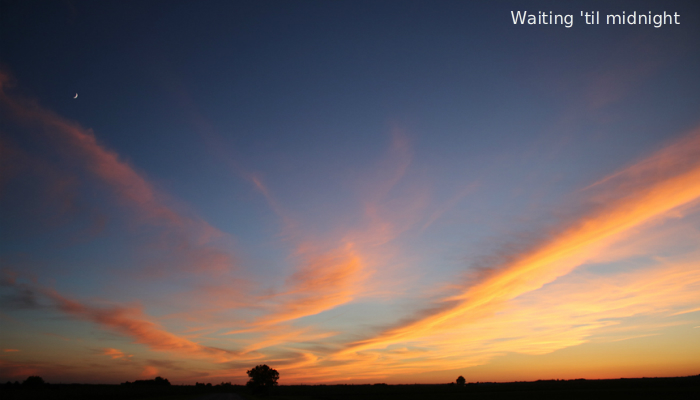Midnight Birdwatching

Large flocks of geese pulsed high overhead this year as the warming days of February transitioned into March. Sometimes wave followed wave like the surf rolling in, and on a couple of occasions the fluid vees were stacked as many as six layers deep. Their speed suggested that they were taking advantage of a substantial tailwind up there. The last I noticed of the great migration by day was March 4th, and the event was the earliest in the calendar year that I can remember.
But as late as March 10th, the night squadrons were still flying, at least on clear nights. I could locate their general position in the sky based on their non-stop conversation. Then I would focus on a constellation that was in their path and watch for stars to flicker as they momentarily blocked the light. The really brief flickers were probably when a wing flicked across a star, while a longer outage was probably the whole goose crossing.
Sometimes I could actually see them, especially if the moon was very low in the sky and illuminating their pale bellies and underwings. That is when selecting a familiar flickering constellation is handy, because it gives me a target to focus my binoculars on.
I’ve only noticed them flying on clear nights and perhaps they only fly then because they can see the landscape below. But maybe they also fly at night above the cloud cover, and the clouds merely muffle their voices to us below. Radar operators and pilots of small planes probably know.
I am fortunate to live rural and burn firewood for heat, because a cooling house sends me outdoors for another armload. And as long as I’m out there, I might as well check out the stars, listen to the night sounds, and occasionally pull on boots and a jacket over my pajamas and take a little midnight stroll in the woods or through the prairie.
More recently, weeks after the migrating geese were long gone, I continued to watch the constellations on clear nights. Occasionally, patches of stars seemed to go through a quick flickering pattern that moved more-or-less north, much like the effect the geese produced, but silent – at least to an old guy with hearing problems. So it made me wonder whether these were flocks of nocturnal migrating songbirds. Regardless of the moon’s position, 7×35 binoculars didn’t reveal anything.
This flickering is so subtle that it resembles the twinkling of stars, which is brought on by starlight moving through shifting air mass boundaries with different refractive indexes. But my observed flickering does have a grouping, with a directionality. Have you ever noticed this pattern in early spring? Or, am I being carried away by my imagination? Can some little birds actually occult a star for a moment at a quarter mile?
Twinkle twinkle little bird
You’re not transparent, so I’ve heard
And I suspect you do not know
Your shadow flicks on us below.
It lets me know you’re up there still
Winging over lake and hill
The night’s more safe for you who fly
When hawks and shrikes have left the sky.
When daylight steals across the land
And you must find somewhere to land
I hope somewhere’s a place that could
Provide you with a sheltering wood.
And still today we do not know
How you learn which way to go
We wish you well upon your flight
Twinkle twinkle all the night.


